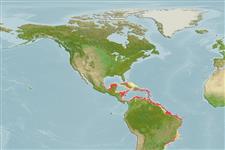>
Clupeiformes (Herrings) >
Engraulidae (Anchovies) > Engraulinae
Etymology: Cetengraulis: Greek, ketos = a marine monster, whale + Greek, eggraulis, -eos = anchovy (Ref. 45335).
More on author: Cuvier.
Environment: milieu / climate zone / depth range / distribution range
Οικολογία
Θαλασσινό(ά); Υφάλμυρο; εύρος βάθους 10 - ? m. Tropical; 23°N - 28°S, 98°W - 32°W (Ref. 189)
Western Atlantic: in the Antilles, from Cuba southward; Costa Rica south and east to Colombia and Venezuela, Trinidad south to Itapema, Santa Catarina, Brazil.
Length at first maturity / Μέγεθος / Βάρος / Age
Maturity: Lm 13.7 range ? - ? cm
Max length : 20.5 cm TL αρσενικό/απροσδιόριστο; (Ref. 125970); common length : 15.0 cm TL αρσενικό/απροσδιόριστο; (Ref. 5217); μεγ. δημοσιευμένο βάρος: 140.58 g (Ref. 125970)
Ραχιαίες άκανθες (συνολικά) : 0; Εδρικές άκανθες: 0; Μαλακές εδρικές ακτίνες: 18 - 24. Head large and deep. Snout short and pointed, about 2/3 eye diameter; maxilla moderate, tip blunt, just failing to reach lower jaw articulation; fine and numerous lower gill rakers, increasing in large fishes; no gill rakers on posterior face of third epibranchial. Branchiostegal rays 8, long and slender; branchiostegal membrane broad. Silver stripe disappearing at about 10 cm SL (Ref. 189). Dusky dots on upper surface of head and snout, series of large black dots along base of anal (Ref. 37032).
Occurs inshore and forms quite large schools. Enters brackish waters of lagoons and estuaries and can tolerate salinities of 10.32-31 ppt (Santa Cruz Canal, Pernambuco, Brazil). A filter-feeder presumably on both phytoplankton and zooplankton. Spawns off the Araya Peninsula, Venezuela from October to January, with a distinct peak in mid-November. Eggs are oval, spawned at 0230-0500 hours along shoreline out to about 1.5 km and hatching at about 20-24 hours later.
Whitehead, P.J.P., G.J. Nelson and T. Wongratana, 1988. FAO Species Catalogue. Vol. 7. Clupeoid fishes of the world (Suborder Clupeoidei). An annotated and illustrated catalogue of the herrings, sardines, pilchards, sprats, shads, anchovies and wolf-herrings. FAO Fish. Synop. 125(7/2):305-579. Rome: FAO. (Ref. 189)
IUCN Red List Status (Ref. 130435: Version 2024-1)
Threat to humans
Harmless
Human uses
αλιεία: περιορισμένης εμπορικότητας; δόλωμα: usually
Εργαλεία
Special reports
Download XML
Διαδικτυακές πηγές
Estimates based on models
Preferred temperature (Ref.
123201): 24.4 - 28, mean 27.4 °C (based on 76 cells).
Phylogenetic diversity index (Ref.
82804): PD
50 = 0.7500 [Uniqueness, from 0.5 = low to 2.0 = high].
Bayesian length-weight: a=0.00490 (0.00386 - 0.00621), b=3.24 (3.17 - 3.31), in cm total length, based on LWR estimates for this species (Ref.
93245).
Τροφικό Επίπεδο (Ref.
69278): 2.1 ±0.07 se; based on food items.
Ελαστικότητα (Ref.
120179): Μεσαίο(α), ελάχιστος χρόνος για διπλασιασμό πληθυσμού 1,4 - 4,4 έτη (K=0.13-0.22; Fec=8,189 (batch fecundity)).
Prior r = 0.55, 95% CL = 0.37 - 0.83, Based on 3 data-limited stock assessments.
Fishing Vulnerability (Ref.
59153): Moderate vulnerability (44 of 100).
Climate Vulnerability (Ref.
125649): Moderate to high vulnerability (50 of 100).
Nutrients (Ref.
124155): Calcium = 189 [109, 487] mg/100g; Iron = 1.52 [0.77, 2.95] mg/100g; Protein = 18.3 [16.7, 19.9] %; Omega3 = 0.389 [0.196, 0.833] g/100g; Selenium = 31.4 [14.3, 73.9] μg/100g; VitaminA = 24.9 [5.4, 82.9] μg/100g; Zinc = 2.65 [1.77, 4.20] mg/100g (wet weight);
